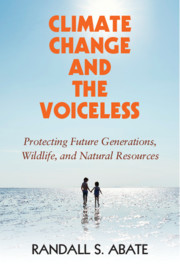Book contents
- Climate Change and the Voiceless
- Climate Change and the Voiceless
- Copyright page
- Dedication
- Contents
- About the Author
- Preface
- Acknowledgments
- 1 An Anthropogenic Problem That Requires an Ecocentric Solution
- 2 Climate Change Litigation in Domestic Courts and Human Rights Commissions
- 3 Protection of Future Generations
- 4 Legal Personhood for Wildlife
- 5 Rights of Nature
- 6 Proposal for Enhanced Stewardship and Rights-Based Protections for the Voiceless
- Subject Index
- Cases Index
5 - Rights of Nature
US and Foreign Domestic Perspectives
Published online by Cambridge University Press: 28 October 2019
- Climate Change and the Voiceless
- Climate Change and the Voiceless
- Copyright page
- Dedication
- Contents
- About the Author
- Preface
- Acknowledgments
- 1 An Anthropogenic Problem That Requires an Ecocentric Solution
- 2 Climate Change Litigation in Domestic Courts and Human Rights Commissions
- 3 Protection of Future Generations
- 4 Legal Personhood for Wildlife
- 5 Rights of Nature
- 6 Proposal for Enhanced Stewardship and Rights-Based Protections for the Voiceless
- Subject Index
- Cases Index
Summary
Chapter 5 shifts the focus to natural resources, the third and final category of the voiceless, and examines the legal initiatives that have sought to protect the rights of nature. Natural resources have been the subject of robust protection in constitutional provisions and legislative enactments in the United States and many other countries. The rights of nature movement has exploded within the past decade and has started to gain traction as a possible tool to combat climate change impacts. One prominent example is the recent effort in Australia that seeks to confer legal personhood to the Great Barrier Reef to help address the impacts of ocean acidification that are decimating this national and international treasure.
- Type
- Chapter
- Information
- Climate Change and the VoicelessProtecting Future Generations, Wildlife, and Natural Resources, pp. 120 - 172Publisher: Cambridge University PressPrint publication year: 2019
- 1
- Cited by

